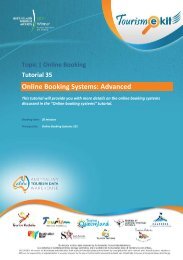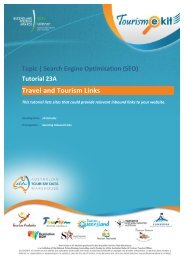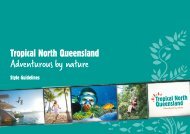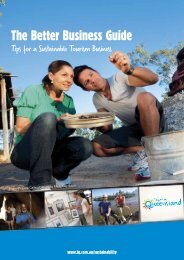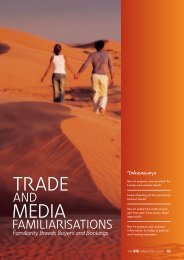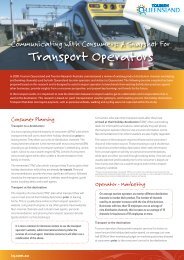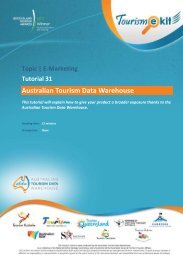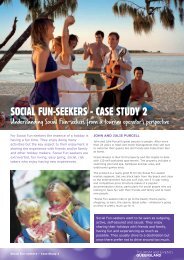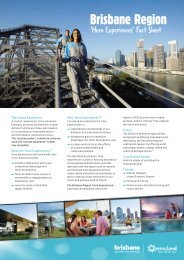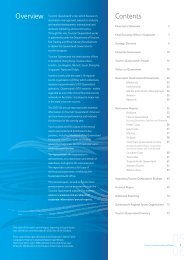The Whitsundays Tourism Opportunity Plan - Tourism Queensland
The Whitsundays Tourism Opportunity Plan - Tourism Queensland
The Whitsundays Tourism Opportunity Plan - Tourism Queensland
Create successful ePaper yourself
Turn your PDF publications into a flip-book with our unique Google optimized e-Paper software.
2 Methodology<br />
Blue<br />
Pearl Bay, Hayman Island<br />
This document is an update of the Mackay <strong>Whitsundays</strong> Regional<br />
<strong>Tourism</strong> Investment and Infrastructure <strong>Plan</strong> (RTIIP) 2006-2016. This<br />
particular document however, relates only to the <strong>Whitsundays</strong> region<br />
(a separate document has been developed for the Mackay region).<br />
<strong>The</strong> original Mackay Whitsunday RTIIP was the very first created in<br />
<strong>Queensland</strong>. This new document focuses on the priority catalyst<br />
projects for the Whitsunday region as determined in consultation<br />
with the <strong>Queensland</strong> State Government, Whitsunday Regional<br />
Council, <strong>Whitsundays</strong> Marketing and Development, Regional<br />
Development Australia Mackay Whitsunday Issac (RDA) and<br />
industry. This reflects the change in priorities over the last five years<br />
and also notes that some of the existing catalyst projects identified<br />
in the previous RTIIP have already been completed.<br />
2.1 TOP Development Methodology<br />
<strong>The</strong> methodology undertaken to develop <strong>The</strong> <strong>Whitsundays</strong> RTIIP in<br />
2006 and subsequently this TOP in 2012 included the following key<br />
steps:<br />
Review of existing background research, reports and literature<br />
with relevance to tourism in the Region;<br />
Consultation with a wide range of stakeholders throughout<br />
this project through one-on-one interviews, attending council<br />
meetings and hosting interactive stakeholder forums;<br />
Analysis of key tourism product gaps and opportunities for the<br />
Region;<br />
Prioritisation of tourism product opportunities against agreed<br />
criteria; and<br />
Review of proposed projects with key stakeholders to develop<br />
final plan.<br />
Stakeholders consulted throughout the project included<br />
representatives from:<br />
■■<br />
■■<br />
■■<br />
■■<br />
■■<br />
■■<br />
■■<br />
Federal Government<br />
State Government<br />
Local Government<br />
Regional <strong>Tourism</strong> Organisations<br />
<strong>Tourism</strong> Associations<br />
Local <strong>Tourism</strong> Organisations<br />
<strong>Tourism</strong> operators<br />
2.2 Project Assessment Criteria<br />
A wide variety of projects have been put forward as part of the<br />
region’s TOP process. In order to undertake an initial assessment<br />
of the feasibility of these projects a set of assessment criteria were<br />
developed in consultation with key stakeholders. <strong>The</strong> agreed criteria<br />
for the assessment of the identified TOP projects were:<br />
Target Market Aligned – does the project meet the needs of<br />
growth target markets for the region?<br />
Destination attributes – does the project capitalise on a<br />
particular destination attribute that would stimulate destination<br />
appeal & visitor interest?<br />
Regional Growth – does the project have the potential to<br />
stimulate growth in the Region over the next 10 years?<br />
Value Added Experiences – does the development of new<br />
products complement rather than unnecessarily compete with<br />
existing products?<br />
Stakeholder Support – does the project have a strong level of<br />
interest from local stakeholders and is the project aligned with<br />
the vision for the region and community aspirations?<br />
Sustainability – do the likely net benefits of the project span<br />
across the social, environmental and/or economic outcomes for<br />
the Region?<br />
Strategic Alignment – does the project align with Local, State<br />
or Federal Government priorities and is it likely to gain support<br />
from the decision makers?<br />
Based on the agreed set of assessment criteria, the identified<br />
projects for the Region’s TOP have been classified into one of the<br />
following categories:<br />
Catalyst Projects – <strong>The</strong>re are the seven catalyst projects<br />
identified for the Whitsunday region. <strong>The</strong>se are tourism<br />
investment or infrastructure projects of regional significance<br />
and which are expected to act as catalysts to generate a range<br />
of other investment, marketing and product development<br />
opportunities.<br />
Key Infrastructure Projects – <strong>The</strong>se region-wide projects are<br />
tourism infrastructure projects which address identified region<br />
wide issues and are expected to act as enablers for further<br />
investment and product development opportunities.<br />
Investment Opportunities – A number of other tourism<br />
investment or infrastructure projects are highlighted as potential<br />
investment, marketing and product development opportunities<br />
for the Region.<br />
2 Methodology<br />
7




